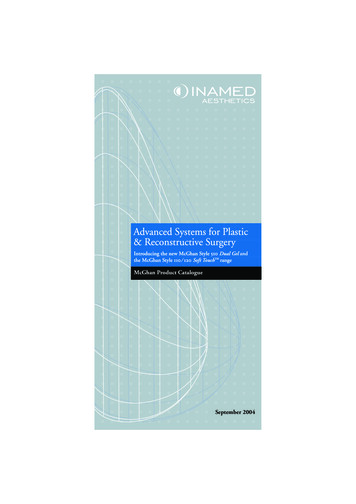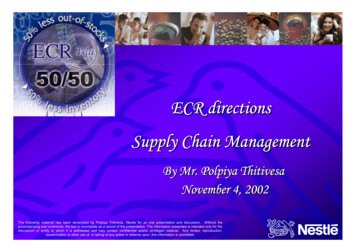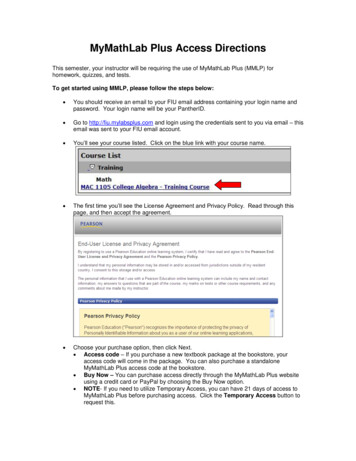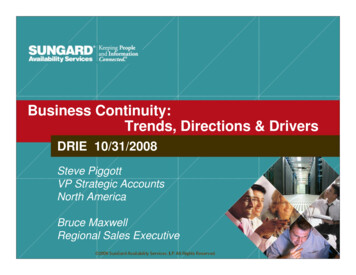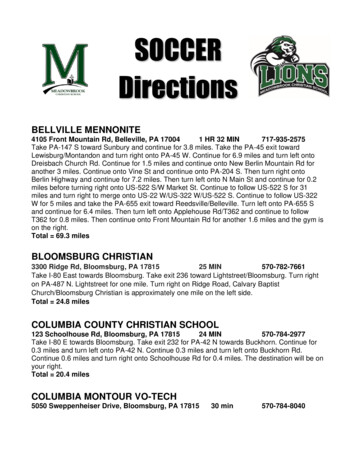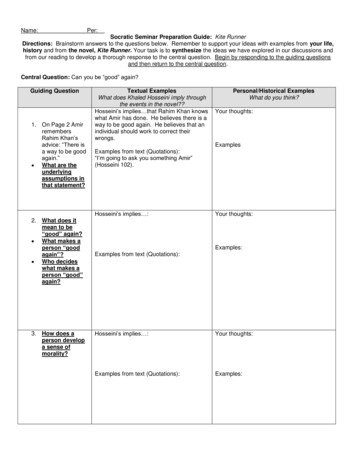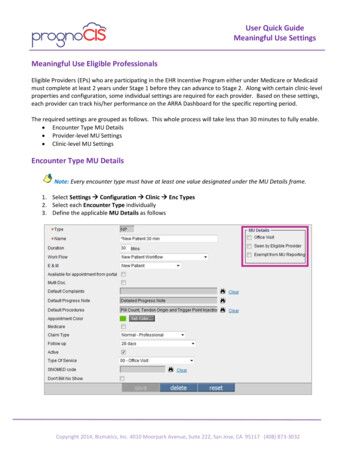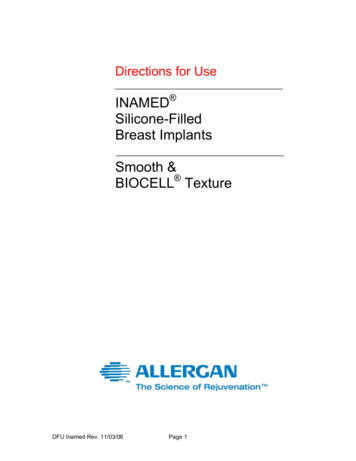
Transcription
Directions for UseINAMED Silicone-FilledBreast ImplantsSmooth &BIOCELL TextureDFU Inamed Rev. 11/03/06Page 1
Caution: Federal (USA) law restricts this device to sale by or on the order of alicensed physicianDFU Inamed Rev. 11/03/06Page 2
TABLE OF CONTENTSPageIntroduction . 3Directions to the Physician. 3Device Description . 6Indications . 7Contraindications . 7Warnings . 7Precautions . 8Important Factors to be Discussed with the Patient. 10Adverse Events . 12Other Reported Conditions . 15Allergan* Core Study. 18Overview of Allergan’s Core Study . 18Primary Augmentation and Revision-Augmentation Patients. 19Primary Reconstruction and Revision-Reconstruction Patients . 26Instructions for Use . 32Single Use. 32Product Identification. 32Surgical Planning . 32Preliminary Product Examination . 32Examination of Silicone Gel-Filled Breast Implants . 32Sterile Product. 33Method for Removing Ruptured Silicone Gel from the Surgical Pocket. 33Surgical Placement Procedure. 33Documentation the Physician Should Provide to the Patient . 34Additional Specific Product Information . 35BIOCELL Delivery Assistance Sleeve . 35Returned Goods Policy . 35Reporting and Return of Explanted Devices . 35ConfidencePlus Limited Warranties . 35Product Ordering. 35Reporting Problems . 35References. 37*formerly InamedDFU Inamed Rev. 11/03/06Page 3
INTRODUCTION DIRECTIONS TO THE PHYSICIANThe information supplied in this Directions for Use document is intended to provide anoverview of essential information about INAMED Silicone-Filled Breast Implants, includingthe indications for use, contraindications, warnings, precautions, important factors for apatient to consider, adverse events, other reported conditions, and a summary of AllerganCore Study results.Patient Counseling InformationYou should review this document prior to counseling the patient about INAMED SiliconeFilled Breast Implants and breast implant surgery. Please familiarize yourself with thecontent of this document and resolve any questions or concerns prior to proceeding with useof the device. As with any surgical procedure, breast implantation is NOT without risks.Breast implantation is an elective procedure, and the patient must be well counseled andunderstand the risk/benefit relationship.Before making the decision to proceed with surgery, the surgeon or a designated patientcounselor should instruct the patient to read Important Information for Women AboutBreast Augmentation/Reconstruction with INAMED Silicone-Filled Breast Implants(patient labeling) and discuss with the patient the warnings, precautions, important factors toconsider, complications, and Core Study results listed in the patient labeling. The physicianshould advise the patient of the potential complications and that medical management ofserious complications may include additional surgery and explantation.Informed DecisionEach patient should receive Allergan’s Important Information for Women About BreastAugmentation/Reconstruction with INAMED Silicone-Filled Breast Implants, which isincluded in the Patient Planner during her initial visit/consultation, to allow her sufficienttime to read and adequately understand the important information on the risks, follow-uprecommendations, and benefits associated with silicone gel-filled breast implant surgery.Allow the patient at least 1-2 weeks after reviewing and considering this information beforedeciding whether to have primary breast augmentation surgery. In the case of a revisionaugmentation it may be medically necessary to perform surgery sooner.In order to document a successful informed decision process, the Patient Planner alsoincludes an Acceptance of Risk and Consent to Surgery document that should be signedby both the patient and the surgeon and then retained in the patient’s file.INAMED Silicone-Filled Breast Implant Physician Certification and EducationCertification via the Allergan Physician Certification Program is required in order to gainaccess to INAMED Silicone-Filled Breast Implants. Physician certification providesdocumentation of training in the use of these devices. Allergan has developed an onlinecertification process that may be accessed via www.allerganacademy.com, or throughparticipation in a live ALLERGAN ACADEMY certification event. Please contact yourlocal Breast Aesthetics Business Development Manager or the Allergan Customer CareDepartment for further information on the INAMED Silicone-Filled Breast ImplantCertification Program, the ALLERGAN ACADEMY or any other Allergan physicianeducation initiatives.DFU Inamed Rev. 11/03/06Page 4
Device TrackingINAMED Silicone-Filled Breast Implants are subject to Device Tracking per FederalRegulation. This means that the physician is required to report to Allergan the serial numberof the implanted device(s), the date of surgery, information relating to the physician’spractice and information on the patient receiving the implant(s). This information shouldrecorded on the Device Tracking Form supplied by Allergan with each silicone gel-filledbreast implant. Return the top portion of the form to Allergan following surgery in theenvelope provided.The bottom portion of the form should be provided to the patient following surgery. Thepatient has the right to have her personal information removed from the Allergan DeviceTracking program. However, Allergan strongly recommends that all patients receivingsilicone gel-filled breast implants participate in the Allergan Device Tracking program. Thiswill help ensure that Allergan has a record of each patient’s contact information. Patientsshould be encouraged to complete the Device Tracking Form and return it to Allergan in thepostage paid business reply envelope provided in their Patient Planner so that they can becontacted in the event of a recall or other problems with the implants that they should bemade aware of.DFU Inamed Rev. 11/03/06Page 5
DEVICE DESCRIPTIONINAMED Silicone-Filled Breast Implants are constructed with barrier shell technologyresulting in a low diffusion silicone elastomer shell and are filled with a soft, cohesive siliconegel. All styles are single “lumen” round design and consist of a shell, a patch, and silicone gelfill. INAMED Silicone-Filled Breast Implants are dry heat sterilized and are available in bothsmooth and BIOCELL surface textureStyle NumberBreast Implant DescriptionSize RangeStyle 10Smooth shell surface, moderate profile120cc – 800ccStyle 15Smooth shell surface, mid-range profile155cc – 752ccStyle 20Smooth shell surface, high profile120cc – 800ccStyle 40Smooth shell surface, moderate profile80cc – 560ccStyle 45Smooth shell surface, full profile120cc – 800ccStyle 110BIOCELL Textured shell surface, moderate profile90cc – 510ccStyle 115BIOCELL Textured shell surface, mid-range profile150cc – 716ccStyle 120BIOCELL Textured shell surface, high profile180cc – 650ccA Width; B ProjectionRound Breast ImplantDFU Inamed Rev. 11/03/06Page 6
INDICATIONSINAMED Silicone-Filled Breast Implants are indicated for females for the following: Breast augmentation for women at least 22 years old. Breast augmentationincludes primary breast augmentation to increase the breast size, as well as revisionsurgery to correct or improve the result of a primary breast augmentation surgery. Breast reconstruction. Breast reconstruction includes primary reconstruction toreplace breast tissue that has been removed due to cancer or trauma or that has failedto develop properly due to a severe breast abnormality. Breast reconstruction alsoincludes revision surgery to correct or improve the result of a primary breastreconstruction surgery.CONTRAINDICATIONSBreast implant surgery should not be performed in: Women with active infection anywhere in their body.Women with existing cancer or pre-cancer of their breast who have not received adequatetreatment for those conditions.Women who are currently pregnant or nursing.WARNINGSAVOID DAMAGE DURING SURGERY Care should be taken to avoid the use of excessive force and to minimize handlingof the implant during surgical insertion.Data accumulated from Allergan’s retrieval study analyses of explanted ruptured siliconegel-filled breast implants, observations of surgeries, and a review of the publishedliterature, indicate that the forcing of implants through too small an opening may result inlocalized weakening of the breast implant shell potentially leading to shell damage andpossible implant rupture.An incision should be of appropriate length to accommodate the style, size, and profileof the implant. The incision will be longer than the one typically made for a saline breastaugmentation. This will reduce the potential for creating excessive stress to the implantduring insertion. Care should be taken when using surgical instruments in proximity with the breastimplant, including scalpel, sutures, and dissection instrumentation.Silicone gel-filled breast implants are prone to unintended instrument trauma duringimplantation or during explantation. 1,2 Failure can result from damage by scalpels,suture needles, hypodermic needles, hemostats, and Adson forceps and has beenobserved in explanted device shells using scanning electron microscopy. 3 Allergan’s(retrieval study) analyses of explanted devices have identified unintended surgicalinstrument damage as one potential cause of implant rupture.DFU Inamed Rev. 11/03/06Page 7
Do not treat capsular contracture by closed capsulotomy or forceful external compression,which will likely result in implant damage, rupture, folds, and/or hematoma. Use care in subsequent procedures such as open capsulotomy, breast pocketrevision, hematoma/seroma aspiration, and biopsy/lumpectomy to avoid damage tothe implant.Re-positioning of the implant during subsequent procedures should be carefullyevaluated by the medical team and care taken to avoid contamination of the implant.Use of excessive force during any subsequent procedure can contribute to localizedweakening of the breast implant shell potentially leading to decreased deviceperformance. Do not contact the implant with disposable, capacitor-type cautery devices. Do not insert or attempt to repair a damaged prosthesis. Do not immerse the implant in Betadine solution. If Betadine is used in the pocket,ensure that it is rinsed thoroughly so no residual solution remains in the pocket. Do not alter the implants or attempt to repair or insert a damaged implant. Do not re-use or resterilize any product that has been previously implanted. Breastimplants are intended for single use only. Do not place more than one implant per breast pocket. Do not use the periumbilical approach to place the implant.MICROWAVE DIATHERMYDo not use microwave diathermy in patients with breast implants, as it has been reportedto cause tissue necrosis, skin erosion, and implant extrusion.PRECAUTIONSSpecific PopulationsSafety and effectiveness have not been established in patients with the following: Autoimmune diseases (e.g., lupus and scleroderma).A compromised immune system (for example, currently receiving immunosuppressivetherapy).Conditions or medications that interfere with wound healing and blood clotting.Reduced blood supply to breast tissue.Radiation to the breast following implantation.Clinical diagnosis of depression or other mental health disorders, including bodydysmorphic disorder and eating disorders. Please discuss any history of mental healthdisorders prior to surgery. Patients with a diagnosis of depression, or other mental healthDFU Inamed Rev. 11/03/06Page 8
disorders, should wait until resolution or stabilization of these conditions prior toundergoing breast implantation surgery.Surgical Precautions Surgical technique – The implantation of silicone gel-filled breast implants involves avariety of surgical techniques. Therefore, the surgeon is advised to use the method whichher/his own practice and discretion dictate to be best for the patient, consistent with thisproduct insert data sheet. It is advisable to have more than one size breast implant in theoperating room at the time of surgery to allow for flexibility in determining the appropriatesize implant to be used. A backup implant should also be available.Implant SelectionSome of the important surgical and implant sizing variables that have been identifiedinclude the following:¾ The implant should be consistent in size with the patient’s chest wall dimensions,including base width measurements, bearing in mind the laxity of the tissue and theprojection of the implant.¾ A thorough discussion should be conducted with the patient, employing appropriatevisual aids such as imaging, sizing implants, or other options to clarify their objectivesand reduce the incidence of reoperation for size change.¾ The following may cause implants to be more palpable: textured implants, largerimplants, subglandular placement, and an insufficient amount of skin/tissue available tocover the implant.¾ Available tissue must provide adequate coverage of the implant.¾ A recent report indicates that larger sized implants ( 350cc) may increase the risk ofdeveloping complications such as implant extrusion, hematoma, infection, palpableimplant folds, and visible skin wrinkling requiring surgical intervention to correct thesecomplications. 4Incision Site Selection¾ The periareolar site is typically more concealed, but it is associated with a higherlikelihood of difficulties in successfully breast feeding as compared to other incisionsites. 5 A periareolar incision may result in changes in nipple sensation.¾ The inframammary incision is generally less concealed than the periareolar, but it isassociated with less breast feeding difficulty than the periareolar incision site. 6¾ The axillary incision is less concealed than the periareolar site.¾ The periumbilical approach has not been studied in Allergan’s Core Study and shouldnot be used for a wide variety of reasons, including potential damage to the implantshell.Implant Placement Selection¾ A well-defined, dry pocket of adequate size and symmetry must be created to allow theimplant to be placed flat on a smooth surface.¾ Submuscular placement may make surgery last longer, may make recovery longer,may be more painful, and may make it more difficult to perform some reoperationprocedures than subglandular placement. The possible benefits of this placement arethat it may result in less palpable implants, less likelihood of capsular contracture, 7 andeasier imaging of the breast for mammography. Also, submuscular placement may bepreferable if the patient has thin or weakened breast tissue.¾ Subglandular placement may make surgery and recovery shorter, may be less painful,and may be easier to access for reoperation than the submuscular placement.However, this placement may result in more palpable implants, greater likelihood ofcapsular contracture, 8,9 and increased difficulty in imaging the breast withmammography.DFU Inamed Rev. 11/03/06Page 9
IMPORTANT FACTORS TO BE DISCUSSED WITH THE PATIENTBreast implantation is an elective procedure and the patient must be thoroughly counseled onthe risks, as well as the benefits, of these products and procedures. You should advise yourpatient that she must read the patient labeling for either augmentation or reconstruction, asapplicable. The patient labeling is intended as the primary means to relate uniform risk andbenefit information to assist your patient in making an informed decision about primary breastaugmentation and revision-augmentation, or primary reconstruction and revisionreconstruction surgery (as applicable), but are not intended to replace consultation with you.The patient should be advised to wait at least 1-2 weeks after reviewing and considering thisinformation, before deciding whether to have this surgery, unless an earlier surgery is deemedmedically necessary.Below are some of the important factors your patients need to be aware of when usingsilicone gel-filled breast implants. Section 1.4 of the patient labeling provides a more detailedlisting of important factors for patients. Rupture – Rupture of a silicone gel-filled breast implant is most often silent (i.e., there areno symptoms experienced by the patient and no physical sign of changes with the implant)rather than symptomatic. The sensitivity of plastic surgeons familiar with implants todiagnose rupture is 30% 10 compared to 89% for MRI. 11 Therefore, you should adviseyour patient that she will need to have regular MRIs over her lifetime to screen forsilent rupture even if she is having no problems. The first MRI should be performedat 3 years postoperatively, then every 2 years, thereafter. The importance of theseMRI evaluations should be emphasized. You should provide her with a list of MRI facilitiesin her area that have at least a 1.5 Tesla magnet, a dedicated breast coil, and a radiologistexperienced with breast implant MRI films for signs of rupture. Diagnostic procedures willadd to the cost of having breast implants, and patients should be told that these costs mayexceed the cost of their initial surgery over their lifetime and that these costs may not becovered by their insurance carrier.Cl
fill. INAMED Silicone-Filled Breast Implants are dry heat sterilized and are available in both smooth and BIOCELL surface texture Style Number Breast Implant Description Size Range Style 10 Smooth shell surface, moderate profile 120cc – 800cc Style
